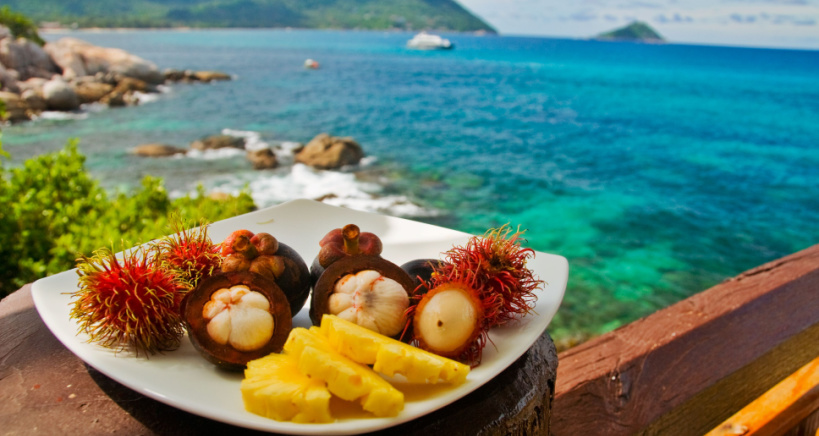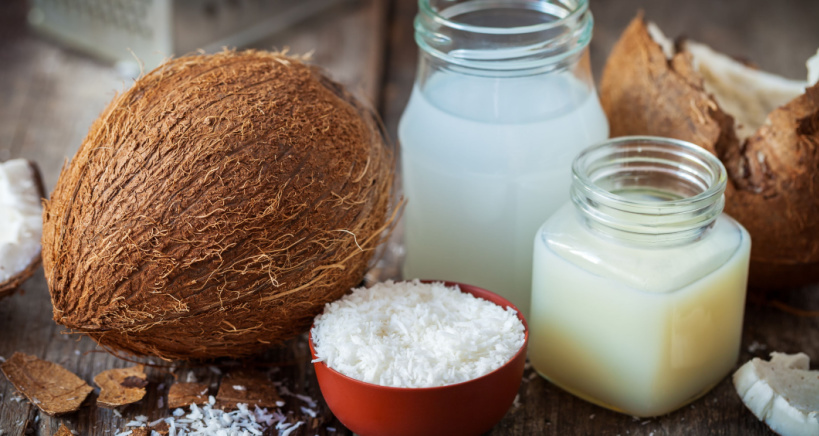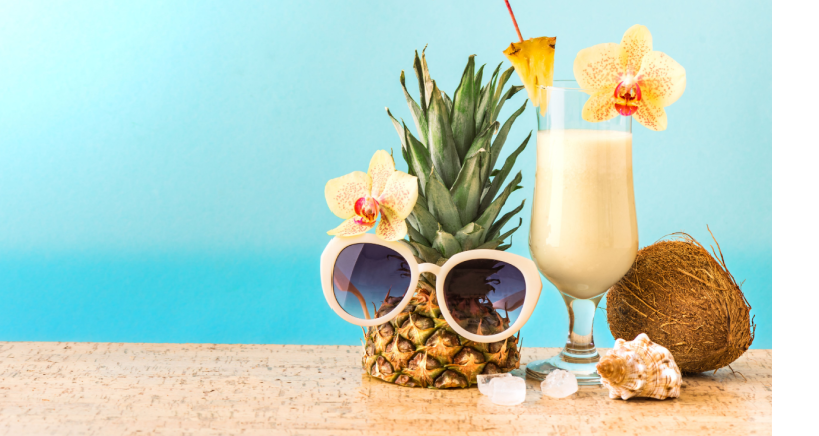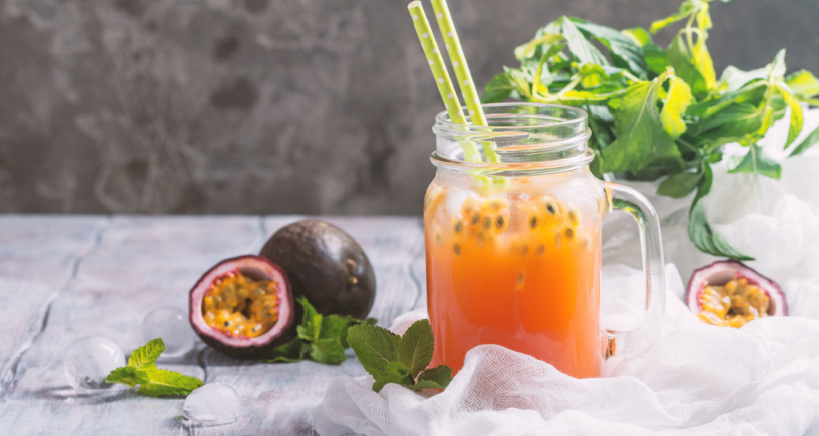
As the weather gets sunnier and warmer every day and the days get longer, it gets harder and harder to keep up with the 9-5. June, July, August: These months are associated with vacations, beaches, sun, clear blue water, waving palm trees. Maybe not everyone can escape their job for the tropical islands – but, it is possible to get a small “taste” of island life by serving up popular island fruits and cuisine at your catered events, cafes, restaurants or home bashes. These sizzling, exotic, and tropical fruits can get your guests in the mood for a little sun and surf!
Island Cuisine – A Bit of History
There are a number of reasons why island fruits and island cuisine are so healthy and popular. Island inhabitants were often isolated from mainland cultures. This gave them the freedom to develop their own completely unique flavor profiles, recipes, and cooking techniques found nowhere else. For example, Pacific Islanders have long relied on Fe’i bananas, which grow in bright oranges and reds, and are cooked before being eaten. Fe’i bananas had ceremonial significance in some island cultures.
As isolated as they were for large parts of history, islands were also waypoints for sailors traveling across oceans, countries, and cultures. Consequently, island flavors tend to incorporate not only traditional ingredients and methods, but also unique fusion flavors. Additionally, non-native tropical fruits introduced later in history, often became key elements of islands’ fusion cuisine. For example, Hawaii’s original inhabitants were Polynesian settlers from the Marquesas Islands. Later, waves of settlers included British, Portuguese, American, and Japanese, among others.
Each group brought their culinary traditions and flavors to the island’s melting pot culture. During this period of cultural exchange, the islands became a major exporter of tropical crops like pineapples and sugar, as well as a stopover for ships crossing the Pacific Islands. Soon after, this tropical fruit became an icon of Hawaiian culture. Similarly, other island cultures developed flavors and preferred fruits that were also a mixture of local and imported ingredients and native and fusion techniques.
Warm, inviting, and sunny year round, combined with above-average rainfall, makes these island nations ideal for growing the sweet and succulent fruit and nutritious vegetables that we associate with tropical cuisine.
Let’s Get Tropical
Tropical islands, being places with plenty of sun, rain, water, and forests, were blessed with an abundance of fresh and healthy foods. From the palm trees decorating the beaches, to the pigs and chickens that roamed the forests, to the variety of fish and seafood swimming near the shore, island people had lots of opportunities to harvest fresh, healthy foods, especially exotic fruits and vegetables. Island cuisine today is known for being nutritious and sustainable and packed with plant-based options.
The Iconic Coconut
Probably the most iconic tropical fruit is the coconut. The tall, waving palm trees that hold these creamy fruits are a symbol of island life. Coconut palms love humid weather, crave rainfall, and grow on sandy, salty shorelines. Coconuts have been a staple of Caribbean and Pacific island cuisine for thousands of years. In modern tropical-inspired cuisine, coconut meat is frequently ground and used in baking, and coconut milk (liquid extracted from the meat) is a common dessert additive and milk substitute. Coconut butter (extracted from the white coconut meat) makes for an exotic butter or jelly substitute. Coconuts are not only tasty, they are also packed with disease-fighting antioxidants, healthy fats, and the “good” HDL cholesterol. They also contain essential nutrients like potassium, manganese, vitamin B, and iron.
How to Process Coconut at Home
It’s not hard to process raw coconut in your own kitchen and turn it into coconut oil, milk, cream, and more. First, you will need to open the hard coconut shell. There are several methods for doing so, depending what tools you have at your disposal, so it’s worthwhile to look up the best method. Scrape out the meat (you can freeze the coconut overnight to make the meat easier to remove), grate it, and now, you have ground coconut meat, your first coconut byproduct. Shredded coconut is popular for adding texture and flavor to baked goods and desserts.

Grind the meat, add water, let it sit, and then drain out the liquid, and you have coconut milk. This versatile ingredient enhances curries, soups, smoothies, ice creams, and cocktails. The leftover coconut meat can be ground and seared in a dry pan, baked on flat oven sheets, or dehydrated to make desiccated coconut, a popular topping sprinkled on ice creams, yogurts, oatmeals, and other foods. Store desiccated coconut in the refrigerator to prolong its shelf life.
Additionally, if you place the coconut milk in the refrigerator for 24 hours, the cream will separate. Freezing the milk will make it easy to skim off the cream. Coconut cream is high in fat, so it makes an ideal dairy substitute in sauces, cakes, whipped cream, and creamy soups. Leave the cream at room temperature (covered) for 24 hours and it will ferment and separate into curd, oil, and water. Freeze the cream for an hour to remove the water, and then let the curd-oil mixture thaw. After two hours the oil will separate and will also be easy to remove. Strain the oil and you will have pure coconut oil, a healthy and aromatic substitute for vegetable oil.
In traditional Southeast Asian and Polynesian cultures, all parts of the tree had their uses; coconut shells were repurposed as bowls, and uncracked coconuts, with their coconut water still inside, made handy on-the-go water bottles for thirsty sailors. If you are handy, and you opened the coconut with a method that preserved its shell, you can sand the shell down to make a bowl. Coconut bowls make great decorative serving dishes for luaus and other island-flavor themed parties.
Sweet, Tangy Pineapple
Pineapples are another luau-famous food, and are associated with Hawaiian culture. Surprisingly, they are actually a new-world fruit, not native to the Hawaiian islands. Because of their sharp, sweet flavor and scurvy-banishing benefits, pineapples managed to hitch their way on ships across the world and probably originated in South America, near Brazil.

An interesting piece of trivia about sailors and pineapples: it’s likely that pirates invented the iconic pina colada drink (which is now the national drink of Puerto Rico) combining rum, pineapples, and coconuts, three staples found in abundance on ships. Pineapples were introduced to Hawaii in the 19th century and, since they grew well in Hawaii’s humid, tropical climate, the islands became one of the major pineapple producers globally. That’s how the spiky fruit became associated with Hawaiian culture.
Pineapples fight scurvy because they are packed with vitamin C. They also contain manganese and fiber. Traditional medicine has used pineapples for centuries to fight disease, and some modern studies back up pineapples’ ability to keep viruses and bacteria at bay. Pineapple is relatively low in calories, with only around 80 calories in one cup of the fruit, so you get all of its health benefits without breaking your diet.
In the home kitchen, many enjoy eating pineapple raw. The fruit can also be roasted, grilled, and even fried. Caramelized pineapple makes for a sweet dessert. Pineapple is also popular in exotic, tropical salsa or chutney. Like many other island flavors, pineapple pairs well with chicken, ham, and seafood. Many even love to add it to their pizza!
The Versatile Mango
The mango got its name through a game of agricultural and cultural broken telephone. Mangos are native to Southeast Asia, where the Indians named it Amra-Phal. When mangos spread to Tamil, they pronounced the fruit Aam-Kaay. People in Southern India, pronounced the fruit’s name in their local accents, Maamkaay. Those in Kerala, Southwest India, turned Maamkaay into Maanga. When the Portuguese landed on the coast of India, they further altered the name, christening the fruit mango. They were responsible for spreading the tropical treat around the world. Thanks to the Portuguese, mango became a Hawaiian and Caribbean island staple.
Mangos are as diverse as they are delicious. They can be pureed and added to sauces or salsas, grilled, eaten raw or put in salads. Mangos can also be added to smoothies and turned into sorbets. Mangos pair especially well with citrus fruits, chili peppers, avocado and vanilla, but it has a versatile flavor that enhances almost any dish.
Mangos are a healthy superfood fruit, containing more than 20 nutrients, including a large amount of vitamin C, vitamin A, and vitamin B6. They are fat-free, but filled with folate and fiber. There are about 100 calories in a cup of mango.
Sweet, Starchy Bananas
Bananas are an extremely popular island fruit. The sweet, starchy variety that we can buy for 25 cents at the grocery store is called the Cavendish banana, and grows well in the Caribbean and Central American region. But, there are thousands of other banana varieties. Another banana that you might actually be able to find at your local grocery is the plantain. Plantains look similar to their Cavendish cousins, but are starchier and less sweet. They are usually fried, baked, or boiled. Some dishes also require ground plantain flour. Fufu de platano is a popular Cuban dish made from mashed plantains.
Plantains are high in fiber and contain many essential nutrients, including vitamin C, potassium, and vitamin B6. However, they are also packed with carbohydrates, so those on a low-carb diet should eat plantains only in moderation, and especially stay away from the fried variety. One cup of raw plantain contains 180 calories.
Taro Roots
Taro is a starchy vegetable that played a major role in the diets of Hawaiians and Pacific Islanders. In Hawaii, the plant was considered sacred, and luau, the name for taro leaves, has come to mean a party or feast. The leaves are edible, but taro’s starchy roots are the real treat. They can be ground up, mixed with water, kneaded, and then fermented to make poi, a tangy, thick, porridge-like Hawaiian staple. This traditional root vegetable is lauded for its health benefits. Not only are they packed with vitamins and minerals, but the carbohydrate content is composed of something called resistant starch. Resistant starches can keep weight down, reduce diabetes risk, and stabilize blood sugar. People on low-carb and keto diets can still enjoy foods with resistant starches. Taro also has lots of dietary fiber, essential for digestive health. One cup of taro has 187 calories.
How to Serve Tropical Fruits
In addition to some of the more well-known, widespread tropical island fruits, there are dozens of niche fruits and vegetables that grow in tropical soils and are integrated into island cuisines.
Some of these include:
- Papaya
- Dragon fruit
- Lychee
- Mangosteen
- Rambutan
- Passionfruit
- Kiwi
- Sweet Potatoes
- Breadfruit
Sometimes it can be hard to find exotic tropical fruit in your local grocery store, especially if you live in a non-tropical climate. If you are looking to use island flavors, but you can’t find fresh dragon fruit or papaya, look for dried, powdered, canned or frozen options instead. Dried papaya, canned pineapple, and dragon fruit powder can still give your recipe that sweet, tropical edge.
Tropical fruits tend to be sweet and tangy, often with a sharp or exotic twist. These flavors are very popular in desserts and in smoothies, which can be made from fresh, powdered, or frozen fruits. Tropical fruits can be colorful and eye-catching. Pineapples’ royal leaf “crown,” passion fruits’ juicy yellow pulp, and the dragon fruit’s arresting color make it easy to visually dress up an island spread. Many tropical island fruits also work well in sauces, salsas, and chutneys, and of course, no luau or island themed party is complete without cool, summery, island-inspired cocktails. But, don’t be scared to serve these fruits on their own as well, raw, boiled, fried, or lightly seasoned, for a taste of the high seas.
Tropical Flavors are for Everyone
America’s melting pot culture has increased the popularity of tropical fruits and island flavors. Many immigrants came from island and tropical countries and cultures where these fruits were ubiquitous. Additionally, young diners enjoy tasting exotic flavors and learning about faraway cultures. Both of these factors play a role in island flavors and tropical fruits becoming a culinary fad.
With island flavors, there is something for everyone. From the adventurous eaters who love to blend traditional and fusion dishes, to those who are looking for something a bit more exotic, cooking with island flavors is an exciting way to spruce up any meal and bring a little taste of sunshine and adventure right into your kitchen. Once tried, these unique flavors will definitely become one of the go-to favorites for your guests. So why not take your taste buds continents away and start experimenting with the flavorful world of island cuisine.
Mixing a Tropical Cocktail

No island flavor themed party is complete without its tropical cocktails or mocktails. This passion fruit sangria can elevate your party beyond the pina colada, and bring an additional element of summer and flavor to the table.
Ingredients:
- 1 bottle of chilled sweet, white wine (like a Moscato or Riesling)
- 1 lemon
- 1 orange
- 1 lime
- 2 cups of passion fruit juice (you can puree this on your own from the raw passion fruit, mixed with sugar and water or you can find this ingredient at Amazon, Walmart, Whole Foods, and other big chain stores)
- 2 cups of pineapple juice (you can buy this from big box stores, make it from fresh pineapple, or even scavenge it from the juice in the can when you use canned pineapples).
- 1/2 cup of brandy
- 1 cup of ginger ale
- 1 sliced kiwi
Instructions:
-
- Pour the wine into a pitcher.
- Rinse the citrus fruits. Cut the lemon, orange, and lime into wedges. Squeeze their juice into the wine, remove the seeds, and put the wedges in the pitcher.
- Add the passion fruit, pineapple and brandy. Stir well.
- When the sangria is ready to be served, pour in the brandy, ginger ale, and kiwi and serve over ice.
- Hipa Hipa! (Cheers)